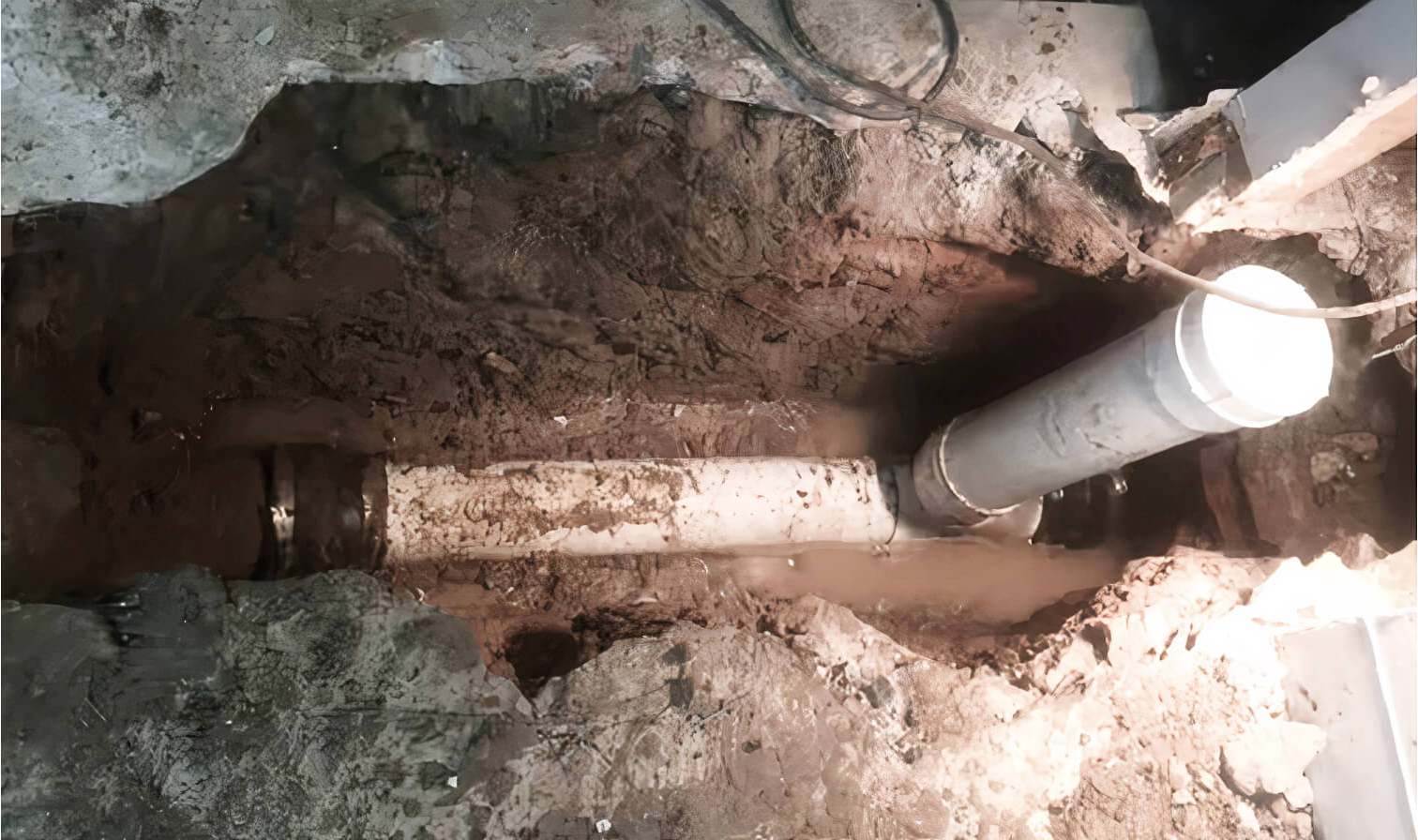When is a basement drainage repair needed?
There are two main ways to deal with flooding in the basement of your own home – overhauling and restoring the waterproofing of the foundation and basement walls or installing drainage in the basement of your home. The comprehensive application of both methods will certainly help to get rid of water completely, but only if you make the drainage effective.
Basement drain pipes are especially prone to clogs because they collect all the water and debris from multiple sources. Clogs occur when debris and sediment accumulate in the pipes over time. Other culprits are damaged, broken pipes or general water flow problems caused by stormwater, which brings dirt and other unwanted deposits. Often a siphon cleaning will help solve this problem. First, you need to find the check valve, a device installed on water pipes to protect drinking water from contaminants. You can remove the cap and clean out the nasty sludge that has settled there. Some homes may have slightly different systems, so if you’re unsure, a professional will utilize modern technology to assist you in identifying drain backup in basement and inform you if repair is necessary.
Guessing or any improper research can lead to bigger problems in the future. Fixing clogs on your own can also lead to potential damage and put your safety at risk. That’s why the most reliable option is to have our plumbing experts diagnose the problem. Superior Plumbing & Heating, which has extensive experience and more than 35 licensed and trained professionals, will help you do it. We work year-round with no holidays as we know you may need assistance anytime. So if you require our services, we are at your disposal.
Why is basement floor drainage slow to drain?
When building a garage or a house, many people prefer to equip the basement, which allows additional storage space for various things and serves as a convenient utility room.
Unfortunately, if mistakes were made during construction, the owners of the house have to deal with such a problem as flooding the basement. Slowly and gradually, moisture destroys the structure, and mould fungus, accompanying its appearance, affects human health most negatively.
Old pipes clogged with debris, grease, and food debris can lead to basement floor drain drains slowly. Drains can become completely clogged and cause flooding. If the water doesn’t go down but goes up the floor drain, you may be dealing with a more serious problem. Flooding is dangerous to your health and can cause significant property damage. Now that you’ve determined that there is a problem with stagnant water in your basement drain, it’s time to fix the problem. But how? Of course, call our technicians, who will eliminate all your problems. In general terms, the work of floor drain repair specialist consists of these steps:
- Remove standing water
- Clean the siphon
- Use chemicals and a plunger
- Clean the drain with a snake
Turning to us, you can be confident in the reliability of our plumbers because they are all trained and certified. Our main priority is the quality and pleasure of our customers.
How to properly clean a drain?
Over time, drain pipes can become clogged, and then their performance and flow capacity deteriorate. The system needs to be flushed and cleaned to get it back in working order. To flush drain pipes as effectively as possible, our technician will select the method that will be most reliable in your particular case. The methods differ in the type of equipment used:
- An ordinary garden hose is a jet of water that runs down the pipe under pressure, allowing it to remove all sorts of deposits from inside the pipe. Given the flexibility of the hose and the insufficient force of the water head, it should be noted that this method can be used for minor clogs when cleaning short pipes;
- Compressor – this equipment will be more effective. It feeds inside the pipe with a mixture of water and air, quickly removing impurities from the surface. The pressure setting can be adjusted here, making it possible to use this technique in some of the most common cases;
- The hydrodynamic method – here, water is fed into the system using a special nozzle on the compressor hose, and many small jets of water are delivered. They sort of tear off the dirt from the walls of the pipe, effectively cleaning the surface. Then the system has to be flushed again with a big stream of water to flush out the dirt from the inside.
In any case, there should be free access to both ends of the drain pipe. On one side, the plumber will supply water, and on the other side, he will make sure it comes out in the right place with an adapter to a hose or other long pipe. Flushing is done alternately on each side of the pipe. That will achieve the best result. If the contamination is quite strong and the drainage system is very poorly permeable, the drainage pipes should be initially cleaned, and only after that – flushing.
The last kind of drain cleaning will allow the drains to function effectively for a long time, eliminating the need for frequent cleaning and flushing. If the plumber cleans your drain pipes but forgets about your drainage system, it will clog up again faster than you expect. Remember also that clogging in your drainage system can be prevented or reduced by using special filters and sand catchers installed at the inlet of each pipe.
Why do basement drain pipes need to be repaired?
Think you have a broken drain pipe in your basement? Don’t worry, it can be fixed with minimal damage to the foundation of your home. There are three most common ways to repair basement drainage pipes:
- Pipe relining. Nowadays, in most cases, damage to sewer pipes can be repaired without digging. Plumbers use modern technology, such as the use of composite resin and synthetic fibres, to patch up damaged areas.
- Repairing drains in the basement. If more than just patching, you need to excavate and replace one or more pipes.
- Cast iron drain pipe replacement. Sometimes it’s best to re-route the plumbing throughout your home. If you are dealing with old piping with significant wear and tear, it will likely continue to fail.
Typically, basement drain repair can be done on your own, but it’s a complicated and smelly job. You will need knowledge and strength. If you don’t know what to do, repairing or replacing your pipes can have serious consequences. You don’t want to trust your plumbing pipes after making repairs or replacements yourself only to find that they burst when you least expect it. This can cause serious damage to your home. Leave it to the professionals.
What types of basement floor drains are there?
When you have water in your home, a floor drain is essential for draining it out of the home. But what type of floor drain should you install? For your convenience, we’ve compiled a list of floor drain types and their uses. The main types of basement floor drain include:
Floor drains
Floor drains are most commonly installed during the initial phase of construction, often in utility rooms, to drain excess water in the basement. The concrete floor around the drain slopes gently toward it, facilitating the accumulation and drainage of water. Standards require most homes to have floor drains leading to a receiving pit, from which the cesspool pump brings water to the surface.
Pros: Indispensable for collecting water from multiple sources. Considered the standard in new construction, so you won’t overpay for its installation when building your home.
Cons: Difficult to install an efficient floor drain in existing basements. Installing a floor drain will not prevent water from leaking through basement walls.
Exterior drainage tile
Installed around the outer perimeter of the foundation, an exterior drainage tile is a highly efficient way to collect groundwater and divert it before it can seep into the basement. Here, a pipe collects the water that accumulates at the base of the foundation walls and directs it to a
Pros: Relatively inexpensive when installed in the initial phase of construction. Effectively diverts groundwater away from the foundation so it can’t seep into the basement.
Cons: Expensive if installed after the house is built. Prone to clogging over time if the specialist does not use proper gravel under, over, and around the perforated pipe.
Interior french drains
French drains can be used to collect surface, storm, and groundwater from the area. Water collected by French drains can be diverted to another location using underground drainage pipes. French drainage usually consists of an underground trench lined with stone with perforated pipes. Depending on the location of the trench, we line the surface of the entire trench with permeable fabric or heavy-duty pond liner.
Pros: Cost-effective if installed during construction of your basement. It collects groundwater from under your basement floor and directs it to a sump pump, where it is evacuated to the surface.
Cons: Internal French drainage only removes groundwater from under the basement floor. It will not stop water from seeping through cracks in the basement walls. Installing internal French drainage in an existing basement is a major project.
How to install a basement drainage system?
The drainage system is usually constructed during the construction phase and is a complicated process.
How to install basement drain system:
- Along the walls of the structure, we dig a trench, drain it and level the bottom;
- Pave the bottom of the trench so that the edges of the material will be enough to wrap the pipes;
- Sprinkle a layer of crushed stone, not forgetting to create a slope. It is necessary that for each linear meter, there should be a height difference of two centimetres;
- Install drainage wells, lay perforated pipes, and connect them in the corners;
- Fill it all up with crushed stone, wrap it in geotextile and cover it with sand, gravel, and soil;
- Dig a central trench, the depth of which should be centimetres lower than the depth of the system for drainage.
- Dig a hole for the installation of the prefabricated tank ten to fifteen meters from the cellar;
- On the trench to the excavated pit, lay the main pipe, install a prefabricated well, connect the system, test, and then fill the trench on the previously described principle.
As you have already realized, this process is difficult to perform yourself, so it is better to turn to professionals. Our company is experienced in repairing and installing a wide variety of drainage systems, so our team knows how to get the job done right. Our plumbers do their best to find problems and discuss all options with each customer to determine the right repair. If you have questions about your drainage system or other services, contact us, and we’ll do whatever it takes to save it from problems today and in the future.

 Call us and we’ll come to you
Call us and we’ll come to you 









